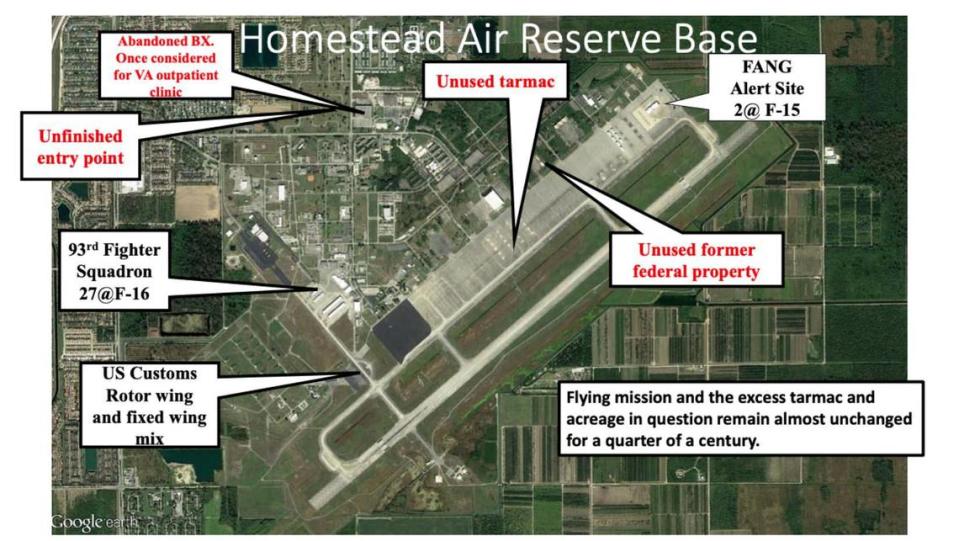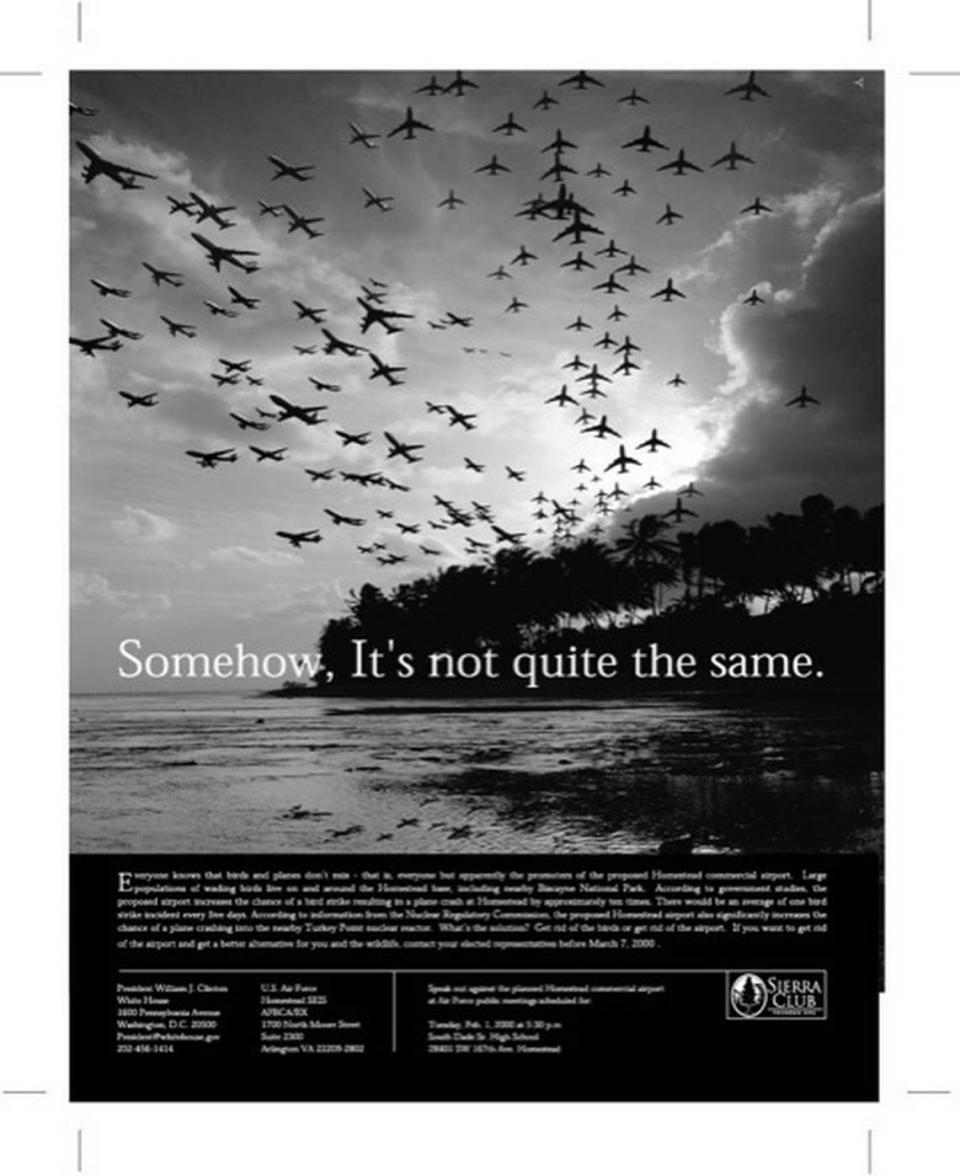With Amazon nearby, activists remain wary of county plans for Homestead Air Base
When county commissioners took the first step toward opening Homestead Air Reserve Base to civilian aircraft six months ago, they insisted the impact on two adjacent national parks would be minimal with a small “fixed base operator” that would cater to private planes.
Yet that’s the exact sort of operation, county documents show, that Miami-Dade business and aviation departments had previously warned would likely fail commercially and was not needed in the southern end of the county.
Environmentalists and other critics monitoring the county’s negotiations with the U.S. Air Force over access to the base’s runway suspect the initial approval amounts to a bait-and-switch. They believe the county, despite plans for a joint-use agreement prohibiting cargo, has left open a door to eventually expand commercial operations there — especially with a FedEx distribution center already open nearby and a planned Amazon facility just a few miles from the base.
Friends of the Everglades, which obtained county memos and emails about the base through a public records request, is asking the Air Force to reject Miami-Dade’s proposal to use Homestead for civilian operations as the county works on a deal with the military. Over 20 years ago, the first effort to turn Homestead into a commercial operation was thwarted in large part because of the noise and pollution that increased flights would bring to Everglades and Biscayne national parks.
“Recent information we have obtained from the County strongly suggests that the County’s current negotiations with the Air Force in support of its joint use agreement request is a prelude to substantial commercial cargo operations, not a Fixed Base Operator,” attorney Paul Schwiep wrote in a letter on behalf of Friends of the Everglades to Robert Moriarty, deputy assistant secretary of the Air Force for installations.
A fixed base operator provides fuel and other general aviation services for small aircraft. Miami Executive Airport, which caters to corporate, recreational, flight training, and governmental agency clients, is an example.
Schwiep said that email exchanges among county aviation staff last year showed they received advice that an FBO at Homestead didn’t fit the county’s aviation needs, and that it would be preferable to support the growth of Miami Executive Airport and Homestead General Airport, which offers skydiving and gliding training and is located next to Everglades National Park.

A June 5, 2020, email from Robert Warren, assistant director for business retention and development at the Aviation Department, to Lester Sola, director and CEO of the Miami-Dade Aviation Department, described how an appraiser didn’t recommend another general aviation airport in the county “and especially at this location,” referring to Homestead Air Reserve Base.
“As I mentioned on the call, we spoke to our appraiser for GAA,” Warren wrote. “He said that the limited demand for private planes who would switch from Ocean Reef would not support an FBO. Also, we need to support growth of TMB (airport code for Miami Executive) and possibly Homestead General as we had planned,” he wrote.
That email raised red flags, Schwiep said, and appears to contradict some of the public arguments that county leaders offered to support a new civilian operator at Homestead. During the Oct. 6 meeting in which the county commission directed staff to work on a deal with the Air Force for the civilian use of the base, former Mayor Carlos Gimenez and commissioners said that providing relief to Ocean Reef traffic was one of the reasons behind plans for an FBO. The short runway at the community’s private airport limits the size and weight of aircraft, so planes can’t operate when fully loaded and often need to make several trips, Gimenez said.
Current chairman Jose “Pepe” Diaz and former commissioner Dennis Moss, who sponsored the item, also said that taking advantage of the base for civilian use was key to economic growth in South Miami-Dade. They said the county is the gateway to the Caribbean and South America, and it’s important to add aviation capacity for future use because of growing tourism and business activity.
Listen to today's top stories from the Miami Herald:
Subscribe: Apple Podcasts | Spotify | Amazon Alexa | Google Assistant | More options
At the meeting, assistant county attorney Cynji Lee also made it clear that general aviation airports do allow cargo traffic, and that the distinction between commercial and general aviation hinges on scheduling of flights and the amount of flight activity.
After Lee’s explanation, former commissioner and now Mayor Daniella Levine Cava, who described herself as a “water warrior” during the campaign and vowed to protect the county’s natural resources, proposed an amendment to prohibit cargo flights. Gimenez endorsed the change, saying that would help alleviate concerns from residents. Moss agreed, saying, “I am fine with this, let’s get something done.” His co-sponsor, Diaz, did not. “I don’t want to hinder any future negotiations on the possibility of some cargo to be done in the future,” he said.
The amendment passed, with commissioners unanimously agreeing to negotiate an agreement with the Air Force.

In an interview with the Herald, Miami-Dade Aviation’s Sola said the county has spelled out its strategy clearly.
“We are not looking to develop Homestead Air Reserve Base into a cargo operation or into a commercial operation. Our mandate has been consistent with a small fixed base operator, and that is the only thing that we are asking from the Air Force,” he said.
The plan is to expand Miami Executive Airport, he said, and eventually figure out where additional air traffic might go. But, he said, a general aviation operation at the military base is an option that could serve as a reliever airport once Miami Executive reaches full capacity.
He said the email exchange cited by Friends of the Everglades was written as part of staff discussions of where the fixed base operator could potentially be located, taking into account the cost of private land should the county want to acquire surrounding plots in order to install buildings and roads to service the operation. Sola said the county doesn’t want to do that at Homestead and envisions an operation staying within the base boundaries.
But Friends and organizations including the Everglades Foundation, Bonefish & Tarpon Trust and the National Parks Conservation Association, among others, fear the base’s 11,200-foot long runway would eventually be used by Amazon for its massive cargo operations. They’ve been mounting a quiet campaign by sending letters to the Air Force every month since December.
They argue that the concerns that led the Air Force in 2001 to decide the area should not be used for aviation-related development purposes — unacceptable threats to natural resources — remain valid today, and are compounded by the presence of a new neighbor next to the base: Amazon. The online retail giant paid the county $22 million last year for a lot near the base, where it’s building a distribution center of at least one million square feet, the largest in Florida.
Amazon didn’t respond to a request for comment. But Sola said the online retail giant doesn’t need a cargo airport next door to operate the warehouse it’s building in Homestead. The business is complicated and diversified, he said.
“Cargo is not just freighters, like cargo-only airplanes. The ideal cargo operation, like what we have at MIA, has cargo planes flying in in the middle of the night bringing cargo only, and then that cargo is broken down into smaller pieces and redistributed on passenger flights,” he said. “And then those passenger flights that went to the Caribbean, to South America, etc., come back to Miami with cargo and passengers as well.”
Sola said there has been no response from the Air Force since the county informed the military in October of its intention to negotiate a joint use agreement for Homestead.
Homestead Air Force Base said it is unaware of any new developments between Miami-Dade and the Department of the Air Force regarding possible access of civil aviation to the base.
“We recognize, and appreciate, that there are many valid concerns surrounding a discussion such as this, but it would be inappropriate for the base to comment beyond recognizing the absolute strategic military importance of our runway, and our commitment to assuring the national missions that operate from it,” Timothy Norton, a spokesman at the base, wrote in an emailed response to questions.
County leaders have promoted the use of the base for civilian operations since Hurricane Andrew ravaged Homestead in 1992. The idea of transforming the heavily damaged base into an airport was one of the options considered to create jobs and support the area’s economic recovery. Proposals to host a Miami version of the Paris Air Show at the base were also considered, but didn’t take off because of opposition from the Pentagon.
In their latest letter to the Air Force’s Moriarty, environmentalists highlighted the economic benefits that Everglades and Biscayne national parks already provide.
“Everglades National Park receives over 1 million visitors per year and is internationally recognized as both a World Heritage Site and Biosphere Reserve. Biscayne Bay receives nearly 500,000 annual visitors and is an important recreational resource for the surrounding greater Miami urban area,” they wrote. “It is time to move on, and provide jobs for the region through a mixed use development which will enhance and not harm threatened environmental resources.”

